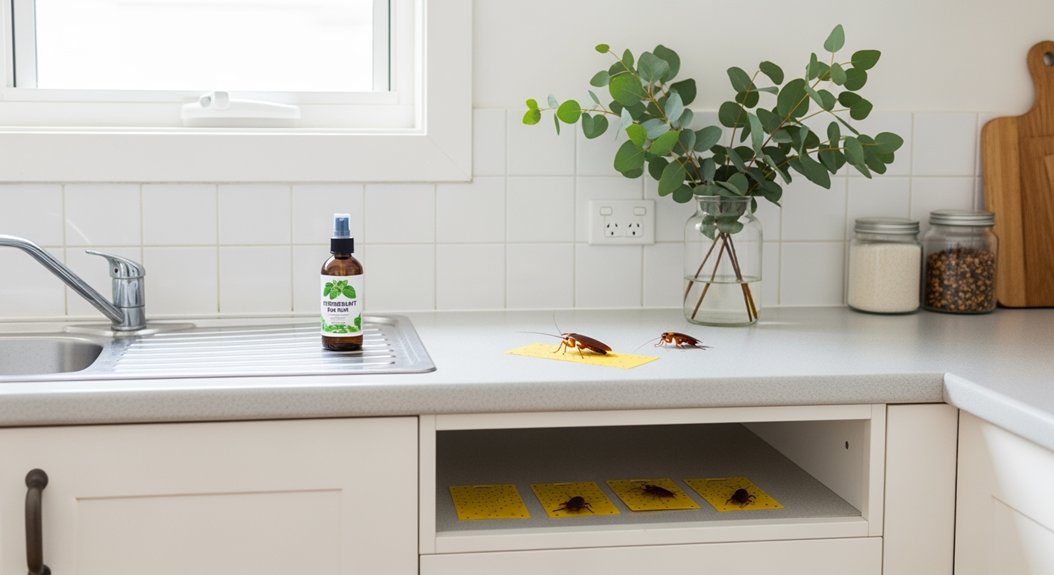Effective cockroach control in Australia involves accurately identifying species to target habitats and behaviors. Combining chemical treatments like pyrethroid sprays and residual liquids with natural remedies such as food-grade diatomaceous earth guarantees rapid and sustained reductions. Preventive measures—including rigorous sanitation, sealing entry points, and removing food and moisture sources—are essential for long-term management. Integrated approaches reduce infestation risks and health impacts. Further exploration reveals detailed strategies and economic considerations vital for thorough cockroach eradication.
Highlights
- Identify the cockroach species (e.g., Australian, German) to tailor targeted control methods and habitat disruption strategies.
- Use insecticide sprays with synthetic pyrethroids or dust formulations like Delta Dust for effective chemical control.
- Apply food-grade diatomaceous earth in thin layers to mechanically kill cockroaches safely, especially in kitchens and bedrooms.
- Maintain rigorous cleaning, seal food in airtight containers, and eliminate moisture to deny cockroaches food and water sources.
- Seal cracks and crevices to prevent entry, use adhesive traps for monitoring, and combine methods for sustained population management.
Understanding Cockroach Habits and Habitats in Australia
Australian cockroaches (Periplaneta australasiae) exhibit distinct behavioral and ecological characteristics that influence their distribution and control.
Their cockroach behavior includes nocturnal activity with occasional daytime movement and a notable attraction to light sources. These insects aggregate in groups and feed on organic material, favoring plant-based food sources such as paper and clothing. They are also known to feed on soft materials like clothes and papers.
Habitat preferences reveal a strong dependence on moisture and warmth. Outdoors, they inhabit greenhouses, woodpiles, and leaf litter, while indoors, they seek subfloor, wall, and roof voids with high humidity, such as crawl spaces and attics.
Understanding these behavioral patterns and habitat preferences is critical for implementing effective prevention and management strategies customized to their environmental requirements and tendencies.
Chemical Solutions for Cockroach Control
Employing chemical solutions remains a cornerstone in effective cockroach control, leveraging a variety of formulations designed to target different infestation scenarios.
Key chemical formulations include insecticide sprays containing synthetic pyrethroids such as deltamethrin and cypermethrin, offering rapid knockdown and residual protection when applied to surfaces and perimeters.
Insecticide sprays with synthetic pyrethroids like deltamethrin provide quick knockdown and lasting residual protection.
Aerosol foggers disperse ultra-fine mists that penetrate crevices, combining insecticides, synergists, and growth regulators to both eliminate current infestations and inhibit development. Cockroach bombs, also known as foggers or total release aerosols, provide an effective means for quick control and residual prevention measures in whole-room treatment.
Dust formulations like Delta Dust provide targeted residual action in voids and behind fixtures, enhancing insecticide effectiveness when integrated with sprays.
Liquid residuals, such as Demand CS and Demon WP, create protective barriers around entry points.
Best results arise from combining these chemical strategies, applying products precisely to infestation hotspots, and adhering strictly to application guidelines for safety and sustained efficacy. Additionally, multiple treatment options are recommended for effective management, especially when dealing with difficult species like German cockroaches.
Natural and Safe Home Remedies
Diatomaceous earth functions as a mechanical insecticide by damaging the exoskeletons of cockroaches, leading to dehydration and death. It is safe for indoor use around pets and children when applied correctly, making it a reliable natural pest control. Baking soda, often combined with sugar, acts as a natural toxicant by producing gas within the pest’s digestive system. Adhesive traps serve as a non-chemical monitoring and control tool, effectively capturing cockroaches and indicating infestation levels for targeted treatment.
Diatomaceous Earth Benefits
Numerous studies have demonstrated that diatomaceous earth (DE) serves as an effective, natural agent against cockroach infestations by physically compromising the insect’s exoskeleton.
The mechanism involves abrasion and absorption of lipids from the protective waxy layer, leading to dehydration and death within 24 to 72 hours. DE exhibits consistent mortality rates of 40% to 80% across various concentrations and life stages, including adults and nymphs. It is important to use food-grade DE for safety, especially in homes with pets and children.
Its pest control advantages include safety for humans and pets due to its mechanical mode of action, eliminating chemical toxicity concerns. Diatomaceous earth applications are ideal for kitchens and bedrooms, applied as a thin, even layer in cockroach-prone areas.
Additionally, DE’s environmental compatibility and effectiveness against multiple pests reinforce its role as a sustainable, practical component in integrated pest management strategies.
Baking Soda Uses
Several natural substances have been investigated for cockroach control, with baking soda emerging as a practical and environmentally safe option.
Baking soda effectiveness relies on its chemical reaction within a cockroach’s acidic stomach, producing lethal carbon dioxide. Since baking soda alone lacks attractiveness, it is combined with sugar or other sweet baits to form effective baking soda traps. A recommended 50/50 sugar-to-baking soda ratio optimizes bait appeal and toxicity. This mixture should be sprinkled in areas where roaches are commonly seen to ensure they consume the bait and are affected by the baking soda’s lethal reaction (best attractant).
Placement in high-activity zones, such as kitchen corners, enhances trap performance. As a non-toxic, residue-free compound, baking soda offers a safer alternative to chemical pesticides, suitable for repeated use around humans and pets.
However, baking soda traps may require multiple applications and integration with other methods to achieve thorough infestation control.
Adhesive Trap Effectiveness
Adhesive traps utilize strong, non-toxic adhesives to effectively capture cockroaches without the use of chemical agents, providing a safe and environmentally friendly solution for pest control. These adhesive trap designs incorporate natural attractants, such as protein-based adhesives and odorless baits, enhancing their efficacy against various cockroach species. Placement near food sources and high-activity areas optimizes capture rates. Their ease of use and eco-friendly disposability make them practical for home environments. The traps are also compact in size, allowing them to be placed in tight spaces like under furniture or inside cabinets, increasing their versatility and effectiveness in pest control compact size.
| Feature | Description |
|---|---|
| Adhesive Type | Non-toxic, protein-based |
| Natural Attractants | Odorless household scraps, natural lures |
| Placement Strategy | Near food, multiple locations, evening setup |
Adhesive traps combine safety and effectiveness, making them a reliable option for natural cockroach control.
Identifying and Managing Invasive Cockroach Species
Effective identification and management of invasive cockroach species require a detailed understanding of their distinguishing characteristics, preferred habitats, and behavioral patterns.
Species identification is critical, as common pests—German, Australian, Brown Banded, American, and Oriental cockroaches—differ markedly in size, coloration, and habitat preferences. For instance, the German cockroach is small with two dark stripes, thriving in kitchens, while the Australian species is larger with bright yellow markings and favors outdoor vegetation and voids. Notably, Australian roaches are attracted to food, moisture, and heat and can sometimes be found indoors seeking these resources.
Identifying cockroach species by size, color, and habitat is essential for effective pest control.
Infestation signs vary by species but typically include feces, egg cases, and sightings in characteristic environments, such as drains for American cockroaches or dry, elevated areas for Brown Banded cockroaches.
Accurate identification informs targeted control measures, optimizing treatment efficacy and reducing health risks associated with contamination and allergen exposure.
Implementing Preventative Measures to Avoid Infestations
Numerous preventative measures are essential to minimizing the risk of cockroach infestations in residential and commercial environments.
Effective preventative cleaning protocols—including daily sweeping, mopping, vacuuming, and wiping down surfaces—remove food particles and moisture that attract cockroaches. Consistent cleaning under appliances and decluttering reduce potential shelter and harborage sites. Cockroaches are nocturnal pests that often hide in dark, moist areas during the day, making thorough cleaning crucial to eliminating their hiding spots.
Proper food storage is critical; using airtight containers denies cockroaches access to nutrition, while prompt removal of spills and crumbs eliminates immediate food sources.
Waste management practices such as using bins with tight-fitting lids and regularly emptying trash further deter infestation.
Additionally, sealing entry points like cracks and gaps around doors, windows, and utility lines prevents ingress.
Together, these integrated measures form a thorough barrier against cockroach colonization, supporting long-term pest control efforts.
Economic and Social Impacts of Cockroach Infestations
Cockroach infestations impose substantial financial burdens on businesses through increased pest control expenses, revenue losses, and regulatory compliance costs. These costs are especially pronounced in urban environments where modern infrastructure supports cockroach proliferation. Concurrently, these infestations present significant public health risks by facilitating the spread of pathogens and exacerbating respiratory conditions. Addressing both economic and health impacts is critical for effective pest management strategies.
Business Financial Burdens
Financial strain represents a critical challenge for businesses confronting cockroach infestations, manifesting through direct costs such as pest control measures, damage repairs, and regulatory fines.
Infestation management greatly elevates business expenses, including eradication, inventory loss, and infrastructure restoration. Compliance failures exacerbate financial liabilities via penalties and legal fees. Cockroaches carry harmful pathogens, spreading diseases like Salmonella and E. coli, which can increase health-related costs and liabilities for businesses.
Operational disruptions during treatment further impede revenue generation and productivity. The cumulative economic impact varies across sectors, with food handling and distribution enduring the highest burdens.
- Elevated pest control and extermination costs
- Damage to inventory and structural assets
- Regulatory fines for hygiene and safety breaches
- Revenue loss due to operational downtime
- Increased legal, insurance, and compliance expenses
Effective infestation management is essential to mitigate these financial burdens and sustain business viability.
Public Health Risks
Although often overlooked, infestations of cockroaches present significant public health risks that extend beyond mere nuisance.
Cockroaches serve as vectors for disease transmission, carrying pathogenic bacteria such as *Salmonella*, *E. coli*, and *Staphylococcus aureus*, which contaminate food and surfaces, leading to outbreaks of foodborne illnesses. Their allergens exacerbate respiratory conditions, particularly asthma, heightening hospital admissions and long-term public health burdens. The Australian Centre for Disease Control identifies cockroaches as highly effective disease spreaders, underscoring their role in public health concerns.
Infestations correlate with substandard housing and hygiene, contributing to social stigma and mental health stress in affected communities. Economically, increased healthcare utilization for treatment of cockroach-related diseases strains public health systems.
Effective pest management and community education are critical to mitigating these risks, ensuring food safety, reducing disease transmission, and improving overall public health outcomes in Australia.
Combining Methods for Effective Long-Term Cockroach Management
When addressing persistent cockroach infestations, integrating multiple control strategies greatly enhances long-term effectiveness. Understanding cockroach behavior and habitat preferences facilitates targeted interventions that disrupt their food, water, and shelter sources. It is important to note that cockroaches can live for 3 to 12 months, making continuous management essential.
Combining knowledge of cockroach habits with diverse control methods disrupts their resources for lasting pest management.
Combining sanitation, exclusion, physical, and chemical controls systematically reduces infestations and prevents recolonization.
Key integrated management actions include:
- Eliminating food and water sources by rigorous cleaning and fixing leaks
- Sealing entry points and potential harborages with caulking and screens
- Deploying sticky traps and organic desiccants to monitor and reduce populations
- Applying targeted insecticidal baits in high-traffic and concealed areas
- Maintaining ongoing inspections and environmental modifications to sustain control
This multifaceted approach guarantees sustainable cockroach suppression by addressing multiple infestation drivers concurrently.
Frequently Asked Questions
Can Cockroaches Survive Underwater or in Extreme Conditions?
Cockroach survival in extreme conditions is notable; they can endure underwater submersion for 30-40 minutes by sealing spiracles and floating. Their tracheal respiratory system enables toughness, although prolonged submersion and warm water reduce survival likelihood.
How Do Cockroaches Affect Pets in the Household?
Cockroach health risks to pets include disease transmission, allergic reactions, and gastrointestinal issues from ingestion. Ensuring pet safety requires sanitation, sealed entry points, and non-toxic control methods to minimize exposure to cockroach contaminants and pesticides.
What Are the Signs of Cockroach Resistance to Insecticides?
Signs of cockroach resistance include altered cockroach behavior that reduces insecticide contact, decreased insecticide effectiveness evidenced by higher survival rates, and cross-resistance to multiple chemicals, indicating evolving genetic adaptations compromising standard pest control measures.
Are There Specific Cockroach Species Unique to Certain Australian Regions?
Native species of cockroaches exhibit pronounced regional differences across Australia. Examples include the wood-inhabiting Australian Wood Cockroach in eastern forests and the burrowing Giant Burrowing Cockroach endemic to northeastern Queensland, reflecting ecological specialization and habitat adaptation.
How Quickly Do Cockroach Infestations Spread Within Multi-Unit Dwellings?
Infestation speed in multi-unit dynamics is rapid, with initial rates near 47-49%, facilitated by shared infrastructure and group behavior. Spread continues despite control, requiring integrated monitoring and environmental interventions to manage persistent transmission effectively.










